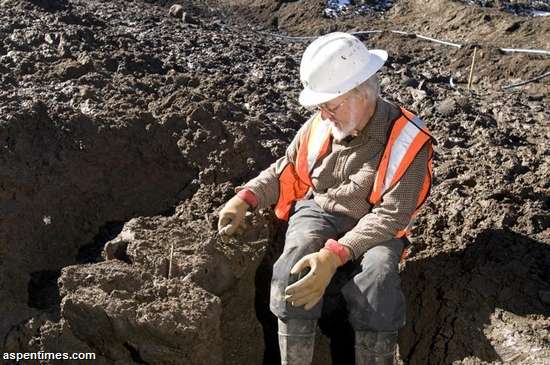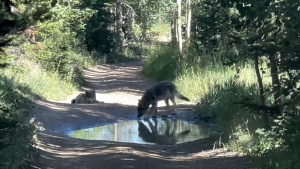‘Huge’ skull the latest find at Snowmass fossil site

ALL |
SNOWMASS VILLAGE – A volunteer paleontologist discovered a large skull, believed to be that of a mastodon, Wednesday morning at the reservoir site near Snowmass Village where the remains of several prehistoric animals have been discovered.Volunteers were also working to encase a 7-foot tusk in a plaster cast so it can be removed from the mud. The tusk could be from a mastodon, or it could be part of what would be the second mammoth discovered at the site, according to Dr. Steve Holen, curator of archaeology for the Denver Museum of Nature & Science.Wednesday was the second day of work at Ziegler Reservoir for a crew assembled by the museum. One volunteer, working where a bulldozer had previously turned up two tusks, began digging around what turned out to be the top of “huge” skull, the museum reported. The bulldozer had apparently grazed the top of the skull, which is difficult to distinguish from the mud around it.Because two mastodon tusks were discovered nearby, Holen believes the skull is from a mastodon.The skull is oriented top up, meaning its teeth and upper jaw should be exposed by further digging. The teeth will aid in a definitive identification of the animal, as the teeth of Columbian mammoths and mastodons are quite different.The skull is about 3 feet long and 2 feet wide, Holen estimated. It has not yet been extracted, he said Wednesday evening. It, too, will be encased in a plaster cast in order to remove it from the soggy earth.”It’s a very delicate process to build a cast around it,” he said.The skull discovery was made by museum volunteer Don Brandborg, a graduate of museum’s paleontology certification program, which trains citizen scientists to assist on fossil digs.About a dozen crew members have been at work at the site this week. Since they are mostly volunteers, the crew’s makeup will change as individuals come and go.”There’s a list of people waiting to come,” Holen said.Scientists have thus far confirmed the discovery of at least three mastodons and one juvenile Columbian mammoth at the site, plus parts of other animals. No woolly mammoths, a different species than the Columbian mammoth, have been documented.”This is an incredible find,” Holen said. “We’ve found evidence of three mastodons and there could be more here.”No other sites have been found in Colorado that contain the remains of both mammoths and mastodons, and only three mastodon discoveries had been recorded in the state before the Snowmass finds, according to the museum. The previous discoveries include two, single teeth found in the early 1900s and a lower jaw bone with a tooth, found on the Front Range last year, Holen said. A 5-foot piece of a tusk was subsequently unearthed at the site of last year’s discovery.The skull in Snowmass would be the first mastodon skull ever found in Colorado.Holen, a mammoth expert, has summoned Dr. Dan Fisher from the University of Michigan to the Snowmass dig. He is the leading expert on mastodons in North America, according to Holen, and is expected to arrive Thursday and stay through the weekend.The American mastodon measured up to 10 feet in height and weighed as much as 6 tons. It lived from some 2 million years ago to about 13,000 years ago, according to the museum. The Columbian mammoth measured up to 13 feet in height and weighed up to 10 tons, and lived from about 100,000 to 13,000 years ago. Both animals ranged across the continental United States and Mexico.By comparison, the African elephant can be as tall as 11 feet and weigh up to 8 tons, the museum noted.The original discovery at Snowmass was the juvenile mammoth, unearthed Oct. 14 by a bulldozer operator working on enlargement of the reservoir. Various additional bones have been discovered since then.The spot where the mammoth bones were found has been enclosed inside a heated tent. A grid has been set up over the site, allowing the crew to dig for more of the fossil in a systematic way.On Tuesday, museum officials returned to Denver with five tusks and the lower jaw of the juvenile mammoth to begin the “delicate process” of preserving the bones, the museum reported.Scientists at the scene have also taken samples of peat and silt from the reservoir, which have been sent to a lab for radiocarbon dating that could help determine the age of the animals that have been found there.Some of the fossils will be on display Friday, when museum officials have scheduled a 10 a.m. press conference in the Capitol Peak Grand Ballroom at the Base Village Conference Center in Snowmass Village. The scientific significance of the site, key findings and the next steps in the ongoing excavation will be discussed by Holen and several curators. The general public is also welcome at the event; parking is available in the Base Village parking garage.janet@aspentimes.com










